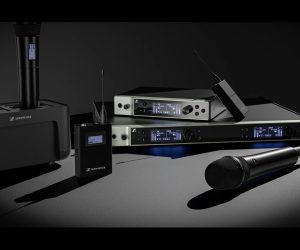
Last Word with Michael Carnes, Part 1

with
Michael Carnes, Part 1
Founder of Exponential Audio
After leaving Lexicon, Michael started up Exponential Audio, a developer of plug-in reverbs and effects. Exponential Audio’s plug-ins are used by lots of top music engineers, and the development of surround, and Atmos and Auro-compatible reverbs make them a favourite for post production.
I spent 25 years at Lexicon.
I was hired in as a senior engineer. It was the early days of workstations, and we made a monster called Opus. We were in competition with companies like New England Digital, Waveframe and AMS Audiofile. All these hardware based, hard disk-operating, editing and mixing systems. It was bleeding edge. We were out front of the market and would beat each other bloody. Opus, for its day — talking the late ’80s — was really amazing. For the low, low price of US$200,000 you could get a 12×8 mixing console and a 12×8 editing system. Anybody’s laptop will do better than that now.
I worked on Opus’ operating system and automation system, eventually managing the project for a couple of years. I begged to be taken off it, and moved into the reverb world. The PCM80 was my first.
I finished up our time in Massachusetts on the 960L, by then I was Principal Engineer. They asked us to move to Salt Lake City, and from that point on I was the sole reverb developer responsible for the IP. I did the PCM96, the 96 Surround, and all those plug-ins. I had people to help with ports and testing, but it was always a small group.
It’s been years since I’ve written one, but I could do a Lexicon algorithm in my sleep. There were certain approaches to the ‘Lexicon sound’. A lot of which came out of getting around the artefacts that arose from trying to do a reverb with pathetic hardware processors.
The issue you mostly encountered was room modes — you’d set up a recirculating delay and various old tricks — it’ll sing like crazy if you don’t actively manage it. My predecessor, David Griesinger, came up with a lot of those tricks to essentially keep it from getting nasty. That was the ‘Lexicon sound’; you could hear modulation, little pitch effects, all sorts of other strange things going on.
For the generation that grew up mixing in the ’80s and ’90s, those artefacts became part of their sound. Almost to a man, they’ll say, ‘That’s natural, that’s depth.’ Nothing could be farther from the truth. You go into a real hall and it never sounds anything like that.
I made a very conscious decision not to emulate the ‘Lexicon sound’. Largely I had to be the ‘Lexicon sound’ for a long time, and while I did a number of things to reduce those artefacts, it always had to sound that way. I knew there were better and more natural ways to do things, but wasn’t allowed to; you were a defender of that sound. It was wonderful to not have to do that any longer.
The ‘right’ sound depends on when you started listening to hit records. If it was the late ’70s and early ’80s, it was the Lexicon 224, and there’s never been anything better. If it was the late ’80s and early ’90s, it was the 480L, nothing ever better. The 960L still had the Lexicon sound but was a departure in a number of ways. For people that started out on that, it was their sound, but was a betrayal to anyone who worked on the older stuff. People are very vocal about their tools.
There are some very successful, established mixers who keep their ears fresh and are not bound by the way they did things before, but it’s hard to escape that. You sit in your room with your old box and dial up a few presets, you’re done thinking about it and move on.
There are a few people who’ve endeavoured to emulate that ‘Lexicon sound’. Plug-ins like the LX480, and some from Universal Audio. There’s nothing creative there, and they typically don’t have the full flexibility of those boxes.
To the best of my knowledge, when I left Lexicon, there really wasn’t anybody to step in. It’s largely stuck where I left it. The old line goes, there’s graveyards full of indispensable people. I’m not posing myself as indispensable, but I think Harman’s interests lie elsewhere. The studio business takes a lot of attention, and when you’re a huge multi-billion dollar company, a bunch of ‘whiny’ mixers in their studios are more bother than they’re worth. ‘Whiny’ mixers are the guys I like.
Modern reverbs are built on only a handful of architectures. There’s the convolution side, which has never been of any interest to me. I’ll give you the rant later. The other architecture, algorithmic reverb, goes back to an old paper published by Schroeder 40 years ago. Everybody’s got a better way to do it than the original paper, and he would be the first to recognise that. But if you look in the DNA, you’ll still find parts of the genome that hark back to that paper.
It’s a field with plenty of trade secrets. I have lots of my own and anyone else in the business has theirs. Who knows, we may have all figured out each other’s secrets. I think they all sound different enough.
I have two different architectures that go in different directions. The Phoenixverb architecture is designed to be natural and unobtrusive. My background is in classical composition. I’ve spent an awful lot of time in concert halls listening to chamber music and symphonies. I know what a good room sounds like from listening to good and bad attributes. The whole point of Phoenixverb was to be able to completely lather the thing in reverb and not really notice it. The dry sound gradually stages into the reverb in a way that it feels ‘in a place’ rather than reverb that’s glued on.
R2 is not a Lexicon reverb, because I get there by different means, but it’s intended to bring back a little of that. The tail is more active, and if you crank things the right way you’ll hear some pitch in the reverb tail and hear it modulate and swirl around. That’s what some people call depth. It’s the farthest thing from it — you don’t hear depth — but it does have some tasty business going on in the back side. Depending on the material, it can be very flattering for a nylon string guitar or singer, when you have a sparse mix and a standout solo you want to drench.
Next issue, Michael gives us the rant on convolution reverb and what’s up with hardware vs software reverbs.
















RESPONSES